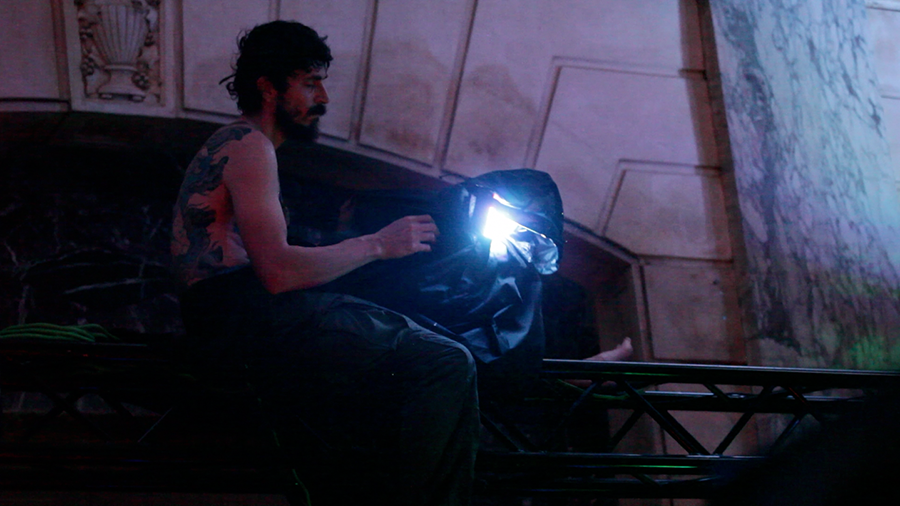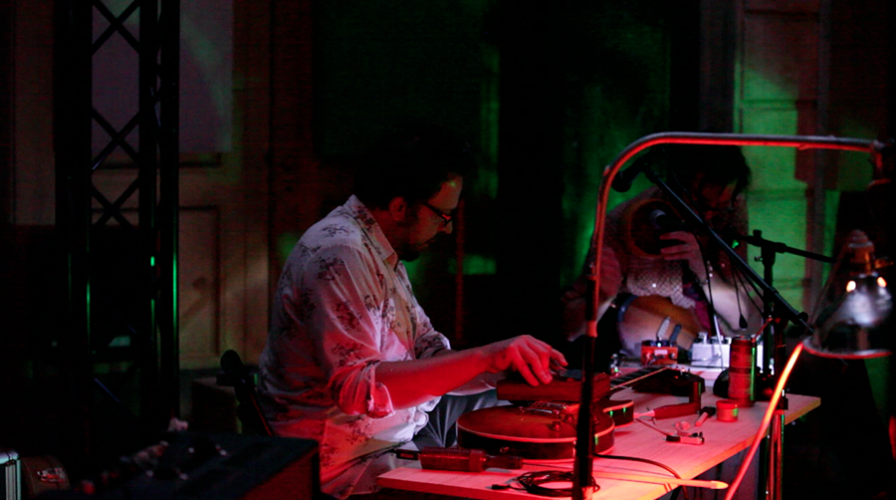It’s hard to believe an institution such as the No-Neck Blues Band (or NNCK) are celebrating their twentieth anniversary this year. Timeless veterans whose work defies easy documentation, they have existed in various (but mostly continuous) forms since Orthodox Easter 1993. Made up of eight individuals who are themselves doyens of the New York underground, the (preferred anonymous) members of NNCK share percussion, guitars, bass, piano, woodwinds, voice, and electronics to create free music that takes cues from previous travelers but buries any reference points in anarchic theatre, ritualized spectacle, and deep listening. Those historical markers might include AMM, Mahogany Brain, Amon Düül, MEV, Seventh Sons, Cromagnon, Godz, Alterations, CCMC, Circle X, and the Art Ensemble of Chicago.
On Orthodox Easter 2013 — traditionally a day of celebration at the old NNCK headquarters in Harlem, now obliterated to make way for Columbia University expansion — De Stijl released digital versions of their back catalog via iTunes, something that seems far afield from the grubby legacy of paste-on mystery. Yet in light of providing access to information, such a move makes complete sense.

On a warm weekend in October, a shade over five months after their official anniversary, NNCK convened for one of their increasingly rare live performances at Issue Project Room in downtown Brooklyn. Two days earlier, a gallery show of the band’s flyers and posters opened at Audio Visual Arts in the Lower East Side, proving — as if such a gesture was needed — that their imprint on New York’s musical history is indelible. Meanwhile, in Brooklyn, where Issue Project Room normally acts as a concert hall — rows of folding chairs set up in its vaulted stone quarters (it’s a former Masonic temple) — it became a space for communion. In this case, it was mostly dedicated to standees or floor-sitters, and became something akin to what one might imagine the American Center in Paris looked like in the late 1960s.
NNCK was preceded by two sets — the first featured Suzanne Langille singing a capella and reading fragments of Kafka, offset by the electronic patchwork of Camissa Buerhaus, while the second was a duo between guitarists Loren Connors and Tom Carter. Both were short, paving the way for an hour-long set of No-Neck in one sprawling and tense improvisation. With their semi-official “drummer” absent for the occasion, the percussion section was scaled back to snare and floor tom, along with an array of cymbals. The group stamped itself out theatrically from the beginning — one individual loping about in a cardboard appliance box, covered in a black sheet while the guitarist/flutist wrapped band members in paper towels and hurled toilet paper into the audience, all amid string scrapes and tinny feedback. With figures stalking the makeshift ‘stage,’ the proceedings took on a surreal menace distinct from the electroacoustic drift and clatter that slowly began to take shape.

Past performances have erupted in somewhat severe actions on the part of the performers — one player cut himself open (accidentally, supposedly) onstage at the 2003 De Stijl Festival in Minneapolis and, on a later occasion, a bladed percussion instrument got alarmingly close to audience members. Amid hurled fruit and participatory acrobatics, NNCK might seem like a Darby Crash-fronted AMM, though a closer analog might be to Actionism (without the sex and macabre). One figure motioned with a glass pitcher, gently tapping it with a woodblock and gesturing to the fact that it could easily be shattered in his hands while a compatriot writhed on the floor, tearing apart cardboard and clutching a large sledgehammer.
The visual element of NNCK has often been a crucial component, and it was certainly in near-full force at Issue Project Room, though one must be careful not to attribute too much to the “performance” of performance. There is a detailed level of communal improvisation that backs up and overcomes the group’s actions, as close-miked drones and deviant accents coagulate into percussive swells, only to fall away into distant nattering. One interesting addition was the employment of the venue’s piano, adding a witheringly romantic undertow, tight comping, and occasional string rattles slicing through the drift. The dry snare attack was often obsessive and lent a mad urge to the music, alternately banal and biting, as organ and guitar swirled and ricocheted off theater walls and Scratch Orchestra tribalism begat punkish rage and progressive slink. Perhaps it was a result of the packed house and captivating space, or the fact that NNCK performances are less frequent now than 10 or 15 years ago, but they were intensely keyed into both one another and whatever strange force guides them to create and antagonize. The music may have been brought together from disparate elements, but it cohered and seemed both logical and with a sense of direction.
It should be mentioned that this performance was part of Issue Project Room’s 10th anniversary fall series (Ten Years Alive on the Infinite Plain), which has brought such diverse figures as Rhys Chatham, Cooper-Moore, Ken Vandermark and Nate Wooley, William Basinski, Omar Souleyman, and Charlemagne Palestine to downtown Brooklyn. Hopefully their work as a venue and organizing body will continue to garner as much support and interest as it has over the last decade. Similar words could be said of the No-Neck Blues Band — here’s to the next two decades.
